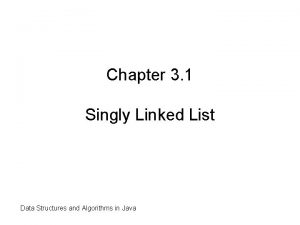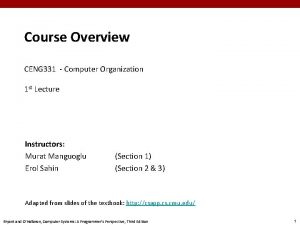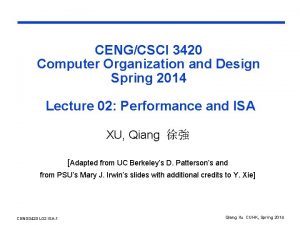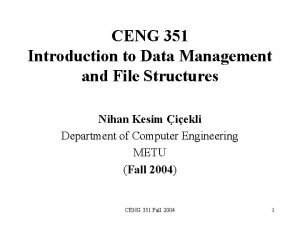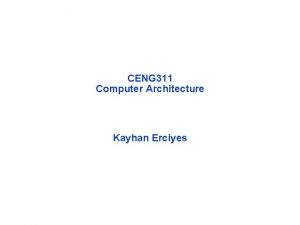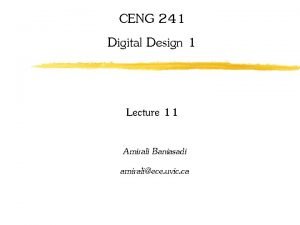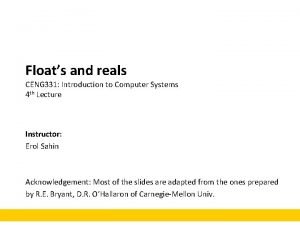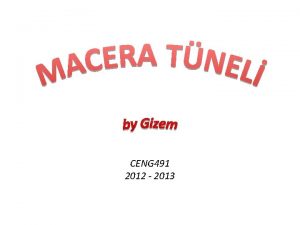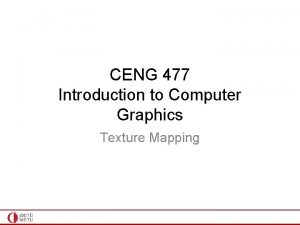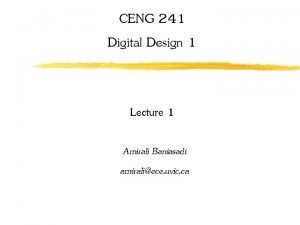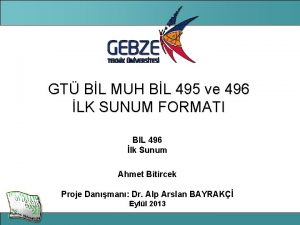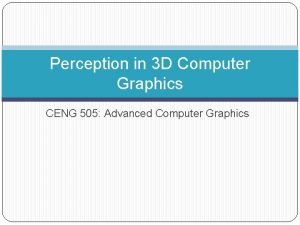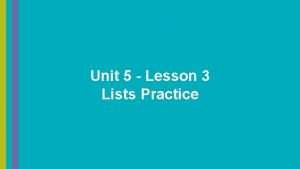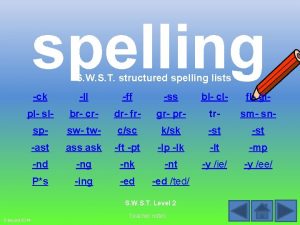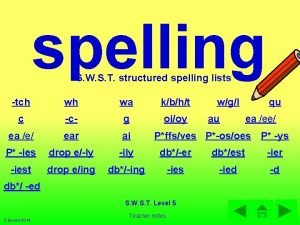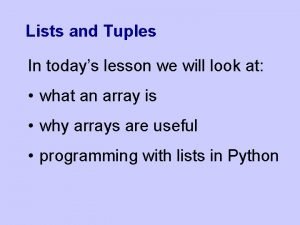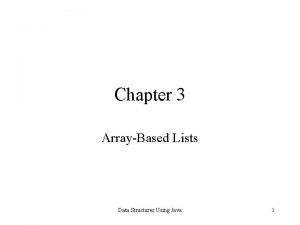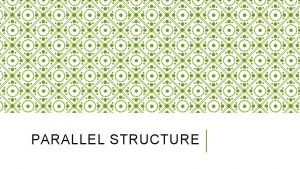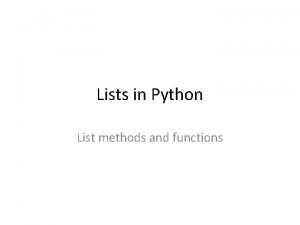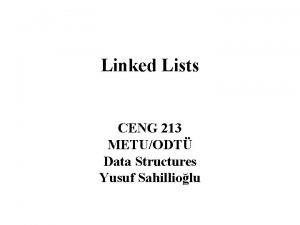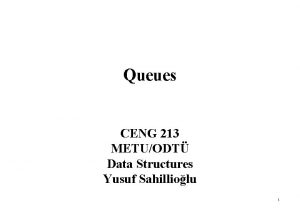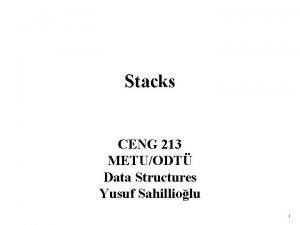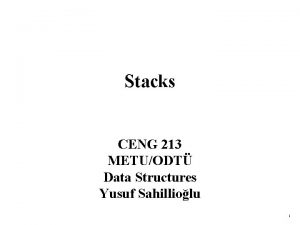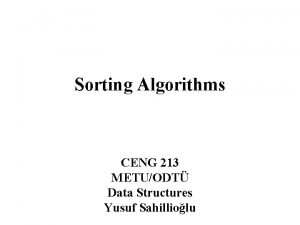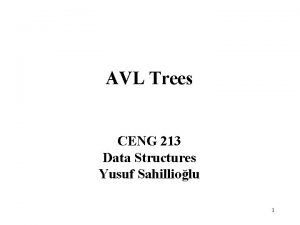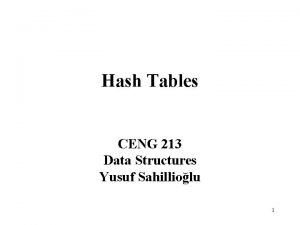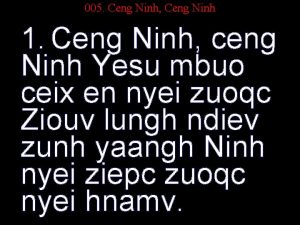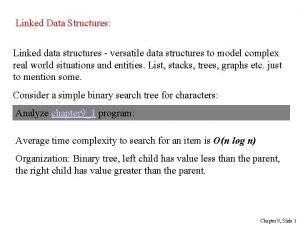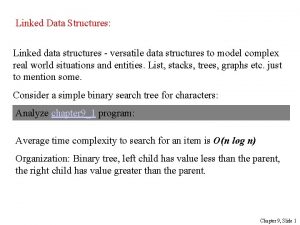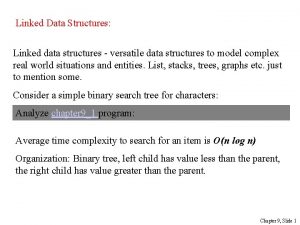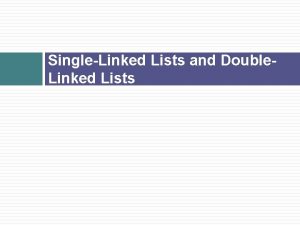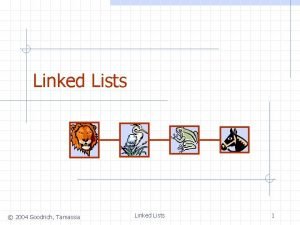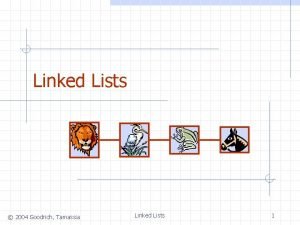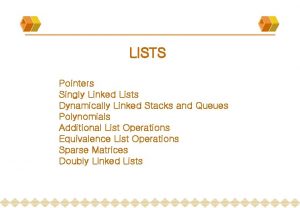Linked Lists CENG 213 METUODT Data Structures Yusuf































































- Slides: 63

Linked Lists CENG 213 METU/ODTÜ Data Structures Yusuf Sahillioğlu

Linked List Basics Linked lists and arrays are similar since they both store collections of data. The array's features all follow from its strategy of allocating the memory for all its elements in one block of memory. Linked lists use an entirely different strategy: linked lists allocate memory for each element separately and only when necessary.

Linked List Basics • Linked lists are used to store a collection of information (like arrays) • A linked list is made of nodes that are pointing to each other • We only know the address of the first node (head) • Other nodes are reached by following the “next” pointers • The last node points to NULL 3

Linked Lists head next a next b First node next c next d Last node

Empty List Empty Linked list is a single pointer having the value NULL. head = NULL; head

Linked List Basics • Each node has (at least) two fields: – Data – Pointer to the next node data ptr 6

Linked List vs. Array • In a linked list, nodes are not necessarily contiguous in memory (each node is allocated with a separate “new” call) • Compare this to arrays which are contiguous Array head Linked List NULL 7

Linked List vs. Array • Advantages of Arrays – Can directly select any element – No memory wasted for storing pointers • Disadvantages of Arrays: – Fixed size (cannot grow or shrink dynamically) – Need to shift elements to insert an element to the middle – Memory wasted due to unused elements • Advantages of Linked Lists: – Dynamic size (can grow and shrink as needed) – No need to shift elements to insert into the middle – Size can exactly match the number of elements (no wasted memory) • Disadvantages of Linked Lists – Cannot directly select any element (need to follow ptrs) – Extra memory usage for storing pointers 8

Linked List vs. Array • In general, we use linked lists if: – The number of elements that will be stored cannot be predicted at compile time – Elements may be inserted in the middle or deleted from the middle – We are less likely to make random access into the data structure (because random access is expensive for linked lists) 9

Linked List Implementation • A linked list node can be represented as follows: template <class T> class Node { public: T element; Node *next; }; 10

Linked List Node Implementation • We can add a constructor to simplify creating a new node: template <class T> class Node { public: Node(const T& e = T(), Node *n = NULL) : element(e), next(n) { } T element; Node *next; }; 11

Linked List Implementation • A linked list can be defined as follows • Note that the constructor creates an empty list by making the head point to NULL template <class T> class List { private: Node<T> *head; public: List() : head(NULL) {} }; 12

Basic Linked List Operations • • • Insert a node Delete a node List Traversal Searching a node Is Empty

Linked List Operations • is. Empty(): returns true if the list is empty, false otherwise template <class T> class List { private: Node<T> *head; public: List() : head(NULL) {} bool is. Empty() const; }; 14

Linked List Operations • is. Empty(): returns true if the list is empty, false otherwise template <class T> bool List<T>: : is. Empty() const { return head == NULL; } 15

Linked List Operations • first(): returns the first node of the list template <class T> class List { private: Node<T> *head; public: List() : head(NULL) {} bool is. Empty() const; Node<T>* first(); }; 16

Linked List Operations template <class T> Node<T>* List<T>: : first() { return head; } 17

Insertion in a linked list a … p b x new. Node …

Insertion • For insertion, we have to consider two cases: 1. Insertion to the middle 2. Insertion before the head (or to an empty list) • In the second case, we have to update the head pointer as well 19

Linked List Operations : insert • insert(const T& data, Node<T>* p): inserts a new element containing data after node p template <class T> class List { private: Node<T> *head; public: . . . void insert(const T& data, Node<T>* p); . . . }; 20

Linked List Operations template <class T> void List<T>: : insert(const T& data, Node<T>* p) { if (p != NULL) { // case 1 Node<T>* new. Node = new Node<T>(data, p->next); p->next = new. Node; } else { // case 2 Node<T>* new. Node = new Node<T>(data, head); head = new. Node; } } 21

Linked List Operations • To avoid this if check at every insertion, we can add a dummy head to our list (also useful for deletion) • This dummy head will be our zeroth node and its next pointer will point to the actual head (first node) dummy. Head (refer to this as `head’ in code – next slides) next X next a First node next b next c 22

Linked List Operations • An empty list will look like this (the contents of the node is irrelevant): dummy. Head next X 23

Linked List Operations • Now, insertion code is simplified: template <class T> void List<T>: : insert(const T& data, Node<T>* p) { // now p should not be NULL. To insert to the // first position, it should point to dummy head Node<T>* new. Node = new Node<T>(data, p->next); p->next = new. Node; } 24

Linked List Operations • We must make some changes to support the dummy head version: template <class T> class List { private: Node<T> *dummy. Head; public: List() { dummy. Head = new Node<T>(T(), NULL); } }; 25

Linked List Operations template <class T> class List { “Note that if we don't private: have a constant first() Node<T> *dummy. Head; function, we cannot public: make is. Empty const as Node<T>* zeroth() { well” return dummy. Head; } Node<T>* first() { return dummy. Head->next; } const Node<T>* first() const { return dummy. Head->next; } bool is. Empty() const {first() == NULL; } 26 };

Searching for an Element • To find an element, we must loop through all elements until we find the element or we reach the end: template <class T> class List { private: Node<T> *dummy. Head; public: . . . Node<T>* find(const T& data); . . . }; 27

Searching for an Element • To find an element, we must loop through all elements until we find the element or we reach the end: template <class T> Node<T>* List<T>: : find(const T& data) { Node<T>* p = first(); while (p) { if (p->element == data) return p; p = p->next; } return NULL; } 28

Removing a node from a linked list tmp a … p x b …

Removing an Element • To remove a node containing an element, we must find the previous node of that node. So we need a find. Previous function template <class T> class List { private: Node<T> *dummy. Head; public: . . . Node<T>* find. Previous(const T& data); . . . }; 30

Finding Previous Node template <class T> Node<T>* List<T>: : find. Previous(const T& data) { Node<T>* p = zeroth(); while (p->next) { if (p->next->element == data) return p; p = p->next; } return NULL; } 31

Removing an Element • Now we can implement the remove function: template <class T> class List { private: Node<T> *dummy. Head; public: . . . void remove(const T& data); . . . }; 32

Removing an Element • Note that, because we have a dummy head, removal of an element is simplified as well template <class T> void List<T>: : remove(const T& data) { Node<T>* p = find. Previous(data); if (p) { Node<T>* tmp = p->next; p->next = tmp->next; delete tmp; } } 33

Removing an Element • Implement an algorithm to delete a node in the middle of a single linked list, given only access to that node (no find. Previous). 34

Printing All Elements (Traversal) • List traversal is straightforward: template <class T> class List { private: Node<T> *dummy. Head; public: . . . void print() const; . . . }; 35

Printing All Elements (Traversal) • List traversal is straightforward: template <class T> void List<T>: : print() const { const Node<T>* p = first(); “Again, the constant first() function allows print() to be const as well” while(p) { std: : cout << p->element << std: : endl; p = p->next; } } 36

Removing All Elements • We can make the list empty by deleting all nodes (except the dummy head) template <class T> class List { private: Node<T> *dummy. Head; public: . . . void make. Empty(); . . . }; 37

Removing All Elements template <class T> void List<T>: : make. Empty() { while(!is. Empty()) { remove(first()->element()); } } 38

Destructor • We must release allocated memory in the destructor template <class T> class List { private: Node<T> *dummy. Head; public: . . . ~List(); . . . }; 39

Destructor template <class T> List<T>: : ~List() { make. Empty(); delete dummy. Head; } 40

Assignment Operator • As the list has pointer members, we must provide an assignment operator template <class T> class List { private: Node<T> *dummy. Head; public: . . . List& operator=(const List& rhs); . . . }; 41

Assignment Operator template <class T> List<T>& List<T>: : operator=(const List& rhs) { if (this != &rhs) { make. Empty(); const Node<T>* r = rhs. first(); Node<T>* p = zeroth(); while (r) { insert(r->element, p); r = r->next; p = p->next; } } return *this; } Uses the const version 42

Copy Constructor • Finally, we must implement the copy constructor template <class T> class List { private: Node<T> *dummy. Head; public: . . . List(const List& rhs); . . . }; 43

Copy Constructor template <class T> List<T>: : List(const List& rhs) { dummy. Head = new Node<T>(T(), NULL); *this = rhs; // use operator= } 44

Testing the Linked List Class • Let's check if our implementation works by implementing a test driver file int main() { List<int> list; list. insert(0, list. zeroth()); Node<int>* p = list. first(); for (int i = 1; i <= 10; ++i) { list. insert(i, p); p = p->next; } std: : cout << "printing original list" << std: : endl; list. print(); 45

Testing the Linked List Class for (int i = 0; i <= 10; ++i) { if (i % 2 == 0) list. remove(i); } std: : cout << "printing odd number list" << std: : endl; list. print(); 46

Testing the Linked List Class List<int> list 2 = list; cout << "printing copy constructed list" << endl; list 2. print(); List<int> list 3; list 3 = list; cout << "printing assigned list" << endl; list 3. print(); list. make. Empty(); cout << "printing emptied list" << endl; list. print(); 47

Testing the Linked List Class for (int i = 0; i <= 10; ++i) { if (i % 2 == 0) { if (list 2. find(i) == NULL) cout << "could not find element " << i << endl; } else { if (list 2. find(i) != NULL) cout << "found element " << i << endl; } } 48

Variations of Linked Lists • The linked list that we studied so far is called singly linked list • Other types of linked lists exist, namely: – Circular linked list – Doubly linked list – Circular doubly linked list • Each type of linked list may be suitable for a different kind of application • They may also use a dummy head for simplifying insertions and deletions 49

Circular Linked Lists • • Last node references the first node Every node has a successor No node in a circular linked list contains NULL E. g. a turn based game may use a circular linked list to switch between players 50

Doubly Linked Lists p. Head a b c Advantages: • Convenient to traverse the list backwards. • E. g. printing the contents of the list in backward order Disadvantage: • Increase in space requirements due to storing two pointers instead of one 51

Deletion old. Node->prev->next = old. Node->next; old. Node->next->prev = old. Node->prev; delete old. Node;

Insertion current new. Node = new Node(x, NULL); new. Node->prev = current; new. Node->next = current->next; new. Node->prev->next = new. Node; new. Node->next->prev = new. Node; new. Node

Circular Doubly Linked Lists • Circular doubly linked list – prev pointer of the dummy head node points to the last node – next reference of the last node points to the dummy head node – No special cases for insertions and deletions 54

Circular Doubly Linked Lists (a) A circular doubly linked list with a dummy head node (b) An empty list with a dummy head node 55

Linked List Problems • See http: //cslibrary. stanford. edu/105/ for some • Here are some cool interview questions • Find nth to last element with one for loop • Keep pointers A & B. Move A n times. Then move both until A ends. • Find if linked list has a loop • A is half speed of B. They will collide if there is a loop. • Print linked list in reverse order • Reverse pointers, then print new list: 1 > 2 > 3 becomes 1 < 2 < 3 print. Rev(Node* n) { • After each recursion, print out the first node void if (! n) return; print. Rev(n->next); print. Rev(1 >2 >3) printf("%dn", n->val); } print. Rev(2 >3) print. Rev(3) //print out 3 (and so on, read to top) print. Rev(NULL) //print out nothing – do nothing • No additional stack space in non rec, but needs 2 passes. Both O(N).

Linked List Problems • More on reversing; assume no Stack around • Cre ate 3 nodes, cur r. N ode, Pre v. N ode and next. Node • Ini tial ize them as cur r. N ode=head; next. N ode= null; pre v. N ode = null; • Now keep revers ing the point ers one by one till curr. Node!=null • In the end set head = prev. Node

Linked List Problems • Merge linked list L 2 into L 1 at alternate positions void List<T>: : alternate. With(List L 2) { Node<T>* p = first(); while (p) { insert(L 2. first()->element, p); L 2. remove(L 2. first()->element); p = p->next; } //end of while }

Linked List Problems • Split linked list L into L 1 and L 2. New linked lists will con tain the alter nate nodes from the given linked list void List<T>: : alternate. Split(List<T> L 1, List<T> L 2) { Node<T>* p = first(), * A = L 1. zeroth(), * B = L 2. zeroth(); while (p) { L 1. insert(p->element, A); A = A->next; p = p->next; if (p) { L 2. insert(p->element, B); B = B->next; } p = p->next; } //end of while }

Linked List Problems • Add two numbers represented by linked a linked list void List<T>: : add(List<T> L 1, List<T> L 2) { if (L 1. length() > L 2. length()) L 2. pad(L 1. length() - L 2. length()); if (L 1. length() < L 2. length()) L 1. pad(L 2. length() – L 1. length()); L 1. set. Prevs(); L 2. set. Prevs(); Node<T>* p = L 1. first(), * q = L 2. first(); while(p->next) p = p->next; while(q->next) q = q->next; int c = 0; List<T> R; //carry and resulting list while (p) {//or while (q) int v = p->element + q->element + c; if (v < 10) { R. insert(v, R. zeroth()); c = 0; } else { R. insert(v%10, R. zeroth()); c = 1; } p = p->prev; q = q->prev; } if (c > 0) R. insert(1, R. zeroth()); }

Linked List Problems • Add two numbers represented by linked a linked list void List<T>: : pad(int n) { for (int i = 0; i < n; i++) insert(0, zeroth()); } void List<T>: : set. Prevs() { Node<T>* p = first(), pr = NULL; while (p) { p->prev = pr; pr = p; p = p->next; } }

Linked List Problems • Add two numbers represented by linked a linked list • Solve using Stack • • Traverse L 1 and L 2 and push elements into S 1 and S 2 S 1. top. And. Pop(e 1); S 2. top. And. Pop(e 2); //call-by-reference v = (e 1==-1? 0: e 1) + (e 2==-1? 0: e 2) + carry; R. insert(v < 10 ? v : v % 10); carry = (v < 10 ? 0 : 1);

Linked List Problems • Fill in the boxes: • You are not allowed to change any existing node’s value field, but you are allowed to use temporary node(s) if necessary. I filled the first entry for you in bold. All lists are terminated by null and the variables a and b have value null when they do not point to anything Use next pointers and not the ADT functions. Size of the given space is arbitrary and does not give a hint about the solution.
 Ceng 213
Ceng 213 Ceng 213
Ceng 213 Hodan yusuf omar
Hodan yusuf omar Singly vs doubly linked list
Singly vs doubly linked list Introduction to linked list
Introduction to linked list List adalah
List adalah Homologous structures example
Homologous structures example Linked data platform
Linked data platform Singly linked list in data structure
Singly linked list in data structure What is polynomial addition in data structure
What is polynomial addition in data structure Json linked data
Json linked data Virtuoso linked data
Virtuoso linked data Json linked data
Json linked data Linked data structure
Linked data structure Polynomial addition using linked list in data structure
Polynomial addition using linked list in data structure Linked open data
Linked open data What is ldbc
What is ldbc Sketch linked data
Sketch linked data Emine ceng
Emine ceng R.p.e. certificate
R.p.e. certificate Cow ceng
Cow ceng Imech
Imech Ceng334
Ceng334 Thk bilgisayar mühendisliği
Thk bilgisayar mühendisliği Citp vs ceng
Citp vs ceng What is the difference between ethics and law
What is the difference between ethics and law Ceng3420
Ceng3420 Ceng 505
Ceng 505 Ceng 351
Ceng 351 Ceng 334
Ceng 334 Iyte ceng
Iyte ceng Ceng 241
Ceng 241 Ceng 240 metu
Ceng 240 metu Bahri tokmak
Bahri tokmak Ceng 477
Ceng 477 Ceng 477
Ceng 477 Ceng 241
Ceng 241 Nem ceng
Nem ceng Ceng 112
Ceng 112 Gtü ceng
Gtü ceng 41/72 simplified
41/72 simplified Ceng302
Ceng302 Metu databases
Metu databases Emine ceng
Emine ceng Texas. heres why.
Texas. heres why. Mskü ceng
Mskü ceng Eur ing vs ceng
Eur ing vs ceng Bilgisayar mühendisliği
Bilgisayar mühendisliği Use of semicolon in a list
Use of semicolon in a list Lesson 3: lists practice
Lesson 3: lists practice Sound waves spelling word lists
Sound waves spelling word lists Swst lists
Swst lists Singular and plural
Singular and plural Resource lists edinburgh
Resource lists edinburgh Concatinates
Concatinates Lists of tuples python
Lists of tuples python Cons in lisp
Cons in lisp Java types of lists
Java types of lists Spelling city words their way
Spelling city words their way Read write inc spelling
Read write inc spelling Empty list prolog
Empty list prolog Parallel list
Parallel list Python lists functions
Python lists functions Inca sun temple of cuzco ap world history
Inca sun temple of cuzco ap world history








